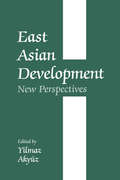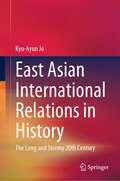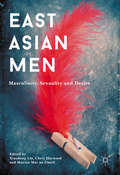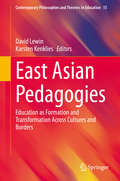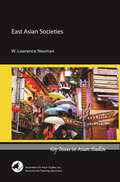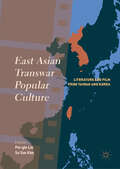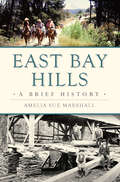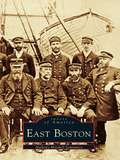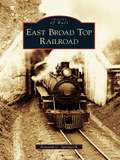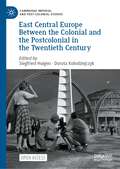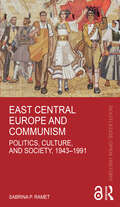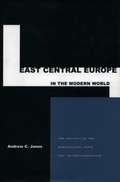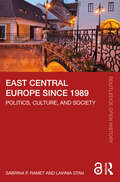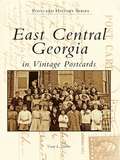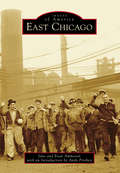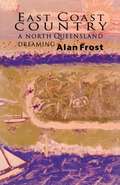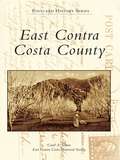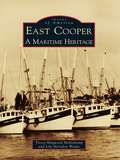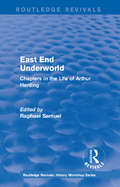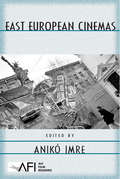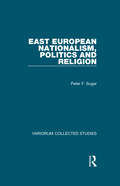- Table View
- List View
East Asian Development: New Perspectives
by Yilmaz AkyüzThis collection of papers challenges the conventional view of East Asian development driven by open and efficient markets and suggests that considerable diversity both at the institutional level and in policy approaches lies behind the region's rapid economic growth.
East Asian International Relations in History: The Long and Stormy 20th Century
by Kyu-hyun JoThis book provides a sweeping overview of East Asian international relations in history from the nineteenth century onwards, with a focus on Korea and its relationship with East Asia and the USA. In contrast with many books which concentrate exclusively on the twentieth century, this book offers a long-term perspective on modernity and modernization in East Asia. It addresses the tributary system, the Meiji Restoration, Japanese imperialism in East Asia, and the Cold War in East Asia. It also incorporates the First and Second Indochina Wars from Vietnam's perspective and expands the geographical scope of East Asia beyond the traditional framework of Korea, Japan, and China. The book begins with the tributary system as a starting point of East Asian modernity in contrast to the old view that the tributary system was not a "modern" system. It rejects the idea that Japan was modernizing while Korea remained stagnant and shows why Japanese colonialism continues to be controversial and problematic. Through the book's emphasis on Vietnam's perspective of the Indochina Wars, it places much value on nationalism, anti-imperialism, and decolonization as forces of modernity and modernization. Relevant to scholars and students in history, international relations, and East Asian studies more broadly, the book brings with it a novel, fresh and innovative approach to East Asian history.
East Asian Men
by Xiaodong Lin Chris Haywood Mairtin Mac an GhaillThis book provides a fresh and contemporary take on the study of men and masculinity. It highlights new and exciting approaches to sexuality, desire, men and masculinity in East Asian contexts, focusing on the interconnections between them. In doing so, it re-examines the key concepts that underpin studies of masculinity, such as homophobia, homosociality and heteronormativity. Developing new ways of thinking about masculinity in local contexts, it fills a significant lacuna in contemporary scholarship. This thought-provoking work will appeal to students and scholars of gender studies, cultural studies and the wider social sciences.
East Asian Pedagogies: Education as Formation and Transformation Across Cultures and Borders (Contemporary Philosophies and Theories in Education #15)
by David Lewin Karsten KenkliesThis book opens up philosophical spaces for comparative discussions of education across ‘East and West’. It develops an intercultural dialogue by exploring the Anglo-American traditions of educational trans-/formation and European constructions of Bildung, alongside East Asian traditions of trans-/formation and development. Comparatively little research has been done in this area, and many questions concerning the commensurability of North American, European and East Asian pedagogies remain. Despite this dearth of theoretical research, there is ample evidence of continued interest in (self-)formation through various East Asian practices, from martial arts to health and spiritual practices (e.g. Aikido, Tai Chi, Yoga, mindfulness etc.), suggesting that these ‘traditional’ practices and pedagogical relations have something important to offer, despite their marginal standing in educational discourse. This book will appeal to all researchers and students of comparative education studies with an interest in issues of interpretation and translation between different traditions and cultures.
East Asian Societies
by W. Lawrence NeumanSo very many teach introductions to East Asia under different disciplines, including the Humanities, Sociology, Economics, History, and Religious Studies, but what makes this work so promising is its transferability across these lines of demarcation for the student engaged in her first serious study of the region. Neuman’s fine overview addresses the recurring cultural tasks across East Asia from family, to school and work, and socio-economic stratifications. Neuman has written an ideal introductory text with a sociologist’s clarity, a humanist’s learning, a researcher’s sharp eye, and a teacher’s fine sense of proportion. This is the only intellectual guidebook you will need to take with you for your voyage to East Asia.
East Asian Transwar Popular Culture: Literature and Film from Taiwan and Korea
by Pei-Yin Lin Su Yun KimThis collection examines literature and film studies from the late colonial and early postcolonial periods in Taiwan and Korea, and highlights the similarities and differences of Taiwanese and Korean popular culture by focusing on the representation of gender, genre, state regulation, and spectatorship. Calling for the “de-colonializing” and “de–Cold Warring” of the two ex-colonies and anticommunist allies, the book places Taiwan and Korea side by side in a “trans-war” frame. Considering Taiwan–Korea relations along a new trans-war axis, the book focuses on the continuities between the late colonial period’s Asia-Pacific War and the consequent Korean War and the ongoing conflict between the two sides of the Taiwan Strait, facilitated by Cold War power struggles. The collection also invites a meaningful transcolonial reconsideration of East Asian cultural and literary flows, beyond the conventional colonizer/colonized dichotomy and ideological antagonism.
East Asian-German Cinema: The Transnational Screen, 1919 to the Present (Routledge Studies in Cultural History #114)
by Joanne Miyang ChoThis is the first edited volume dedicated to the study of East Asian-German cinema. Its coverage ranges from 1919 to the present, a period which has witnessed an unprecedented degree of global entanglement between Germany and East Asia. In analyzing this hybrid cinema, this volume employs a transnational approach, which highlights the nations’ cinematic encounters and entanglements. It reveals both German perceptions of East Asia and East Asian perceptions of Germany, through analysis of works by both German directors and East Asian/East Asian-German directors. It is hoped that this volume will not only accelerate cross-cultural exchange, but also provide a wider perspective that helps film scholars to see the broader contexts in which these films are produced. It introduces multiple compelling topics, not just immigration, multiculturalism, and exile, but also Japonisme, children’s literature, musical modernity, media hybridity, gender representation, urban space, Cold War divisions, and national identity. It addresses several genres—feature films, essay films, and documentary films. Lastly, by embracing three East Asian cinemas in one volume, this volume serves as an excellent introduction for German cinema students and scholars. It will appeal to international and interdisciplinary audiences, as its contributors represent multiple disciplines and four world regions.
East Bay Hills: A Brief History (Brief History)
by Amelia Sue MarshallLike the mist rising from San Francisco Bay encircles the towering redwoods, the little-known legends of the East Bay Hills enrich a glorious history. Follow the trails of Saclan and Jalquin-Yrgin people over the hills and through the valleys. Ride with the mounted rangers through the Flood of ’62. Break into a sealed railroad tunnel with a pack of junior high school boys. Learn how university professors, civil servants and wealthy businessmen planned for years to create a chain of parks twenty miles along the hilltops. Author Amelia Sue Marshall explores the heritage of these storied parklands with the naturalists who continue to preserve them and the old-timers who remember wilder days.
East Boston
by Anthony Mitchell SammarcoOriginally called Noodle's Island, East Boston was once comprised of five islands connected by marshland. Today, many people identify East Boston as the location of Logan International Airport, but it is really much more than that. From colonial times through the late twentieth century, the neighborhood of East Boston has experienced significant developments in the fields of city planning, transportation, and urban development. Until the nineteenth century, East Boston was a rural community whose land was used for grazing and firewood. The East Boston Company was incorporated by William Hyslop Sumner in 1833 to plan the residential and commercial growth of this Boston neighborhood. Connecting East Boston to the city were various modes of transportation including ferries, railroads, and an underground streetcar tunnel. In the 1920s, construction of the Boston Airport, later Logan International Airport, was begun.
East Broad Top Railroad
by Kenneth C. SpringirthChartered in 1856, the East Broad Top Railroad began operating in 1873 through scenic Huntingdon County in south-central Pennsylvania. This well-managed narrow-gauge railroad connected the isolated Broad Top Mountain coal field with the Pennsylvania Railroad at Mount Union. With a decline in the hauling of coal, service ended in 1956. Nick Kovalchick, president of the Kovalchick Salvage Company of Indiana, Pennsylvania, purchased the railroad and reopened a portion of it as a tourist line in 1960. Through vintage photographs, East Broad Top Railroad showcases the steam locomotives, rolling stock, and railroad yard at Rockhill Furnace, which is the most historic railroad yard in North America.
East Carolina University
by John Allen Tucker Arthur CarlsonEast Carolina University was founded by the State of North Carolina in 1907 as a teacher training school meant to provide professionally trained faculty for schools in the eastern part of the state. Within two decades, the school matured into a teacher's college. Although coeducational from the start, the vast majority of the student body early on was female. Following World War II and the gender transformation of higher education resulting from successive GI Bills, East Carolina emerged with increasing balance as the male student body grew to match the female population on campus. In subsequent decades, East Carolina continued to expand academically, emerging as a research university with a medical school and a dental school. Today, ECU is a leading producer of K-12 teachers in the Southeast as well as a leader nationwide in training practitioners of family medicine. The impressive development of East Carolina has flowed from its embodiment of the school's ethic of service to the local community and, in the broadest context, the best interests of humanity.
East Carolina University Football (Images of Sports)
by John Allen Tucker Arthur Carlson Elizabeth Brooke TolarEast Carolina University played its first intercollegiate football game on October 29, 1932, against the Scots of Presbyterian Junior College. In the more than eight decades that have followed, the ECU Pirates have experienced triumph and tragedy while creating a premier game-day experience. From the team's early days playing on farmland through the decade-long quest to join the Southern Conference, ECU's rise is recounted through these pages. Players are featured alongside legendary and colorful coaches in this history of Pirate football.
East Central Europe Between the Colonial and the Postcolonial in the Twentieth Century (Cambridge Imperial and Post-Colonial Studies)
by Siegfried Huigen Dorota KołodziejczykThis open access book explores the ambiguity of East Central Europe during the twentieth century, examining local contexts through a comparative and transnational reworking of theoretical models in postcolonial studies. Since the early modern period, East Central Europe has arguably been an object of imperialism. However, at the same time East Central European states have been seen to be colonial actors, with individuals from the region often associating themselves with colonial discourses in extra-European contexts. Spanning a broad time period until after the Second World War and covering the governance of Communism and its legacies, the book examines how cultural and literary narratives from East Central Europe have created and revised historical knowledge, making use of collective memory to feed into identity models.
East Central Europe and Communism: Politics, Culture, and Society, 1943–1991 (Routledge Open History)
by Sabrina P. RametThe communists of East Central Europe came to power promising to bring about genuine equality, paying special attention to achieving gender equality, to build up industry and create prosperous societies, and to use music, art, and literature to promote socialist ideals. Instead, they never succeeded in filling more than a third of their legislatures with women and were unable to make significant headway against entrenched patriarchal views; they considered it necessary (with the sole exception of Albania) to rely heavily on credits to build up their economies, eventually driving them into bankruptcy; and the effort to instrumentalize the arts ran aground in most of the region already by 1956, and, in Yugoslavia, by 1949. Communism was all about planning, control, and politicization. Except for Yugoslavia after 1949, the communists sought to plan and control not only politics and the economy, but also the media and information, religious organizations, culture, and the promotion of women, which they understood in the first place as involving putting women to work. Inspired by the groundbreaking work of Robert K. Merton on functionalist theory, this book shows how communist policies were repeatedly undermined by unintended consequences and outright dysfunctions.
East Central Europe in the Modern World: The Politics of the Borderlands from Pre- to Post-Communism
by Andrew C. JanosThrough changes from western liberalism to corrupted parliamentarianism, from fascism to state socialism, and now to capitalist democracy, Janos (political science, U. of California- Berkeley) finds a persistence of challenges in the region's economic backwardness compared with the West, the debilities of small nationhood, and the cultural divide between lands of eastern and western Christianity. He seeks a balance between cultural and economic explanations of conflict, between structural and institutional approaches to politics, and between forces inside and outside society as shapers of power and politics in the states. Annotation c. Book News, Inc., Portland, OR (booknews.com)
East Central Europe since 1989: Politics, Culture, and Society (Routledge Open History)
by Lavinia Stan Sabrina P. RametThis groundbreaking treatment of post-communist developments in East Central Europe examines politics, economics, media, religious institutions, transitional justice, gender inequality, and literature, highlighting the overt functions, latent functions, and side effects associated with each sphere.Communism in East Central Europe had cracks from the beginning, as uprisings in East Germany in 1953 and Hungary in 1956 demonstrated. But with the establishment of the Independent Trade Union Solidarity in Poland in the Summer of 1980, communism went into steady decline and, between 1988 and 1991, crumbled. What followed has been an unsteady transition to various forms of often corrupt pluralism with democracy doing best in the Czech Republic (with the exception of the years 2017–2021) and Slovenia, and worst in Hungary, Albania, Serbia, and Bosnia-Herzegovina. Drawing on the functionalist theory of Robert K. Merton, the authors examine what policymakers – communist and post-communist – were or are trying to accomplish, the intended and unintended results of these policies, and the side-effects they have produced. This volume will be of interest not only to specialists in East Central Europe but also to graduate and undergraduate students, members of the diplomatic corps, and general readers.
East Central European Crisis Discourses in the Twentieth Century: A Never-Ending Story? (Ideas beyond Borders)
by Balázs Trencsényi Lucija Balikić Una Blagojević Isidora GrubačkiThe term “crisis,” with its complex history, has emerged as one of the pivotal notions of political modernity. As such, reconstructing the ways the discourse of crisis functioned in various contexts and historical moments gives us a unique insight not only into a series of conceptual transformations, but also into the underlying logic of key political and intellectual controversies of the last two centuries. Studying the ways crisis was experienced, conceptualized, and negotiated can contribute to the understanding of how various visions of time and history shape political thinking and, conversely, how political and social reconfigurations frame our assumptions about temporality and spatiality.A historical region wedged in between various competing imperial centers, East Central Europe has been an area often associated with crisis phenomena by both internal and external observers. Seeking to employ the regional gaze as a vantage point to reflect on issues which are relevant well beyond those countries between the Baltic and the Adriatic, this project is also in dialogue with a number of recent transnational attempts to rethink political and intellectual history with regard to the recurrent epistemological frames that structure the political and cultural debate.This book will thus be useful both for researchers, from the field of intellectual history and numerous adjacent fields, and graduate university students alike.
East Central Georgia in Vintage Postcards
by Gary L. DosterFrom the 1890s through the 1920s, the postcard was an extraordinarily popular means of communication, and many of the postcards produced during this "golden age" can today be considered works of art. Postcard photographers traveled the length and breadth of the nation snapping photographs of busy street scenes, documenting local landmarks, and assembling crowds of local children only too happy to pose for a picture. These images, printed as postcards and sold in general stores across the country, survive as telling reminders of an important era in America's history. This fascinating new history of East Central Georgia showcases more than two hundred of the best vintage postcards available.
East Chicago (Images of America)
by Andy Prieboy Jane Ammeson Evan AmmesonOnce an almost impenetrable landscape of dunes, marshes, and woodlands hugging the southern shore of Lake Michigan, the land comprising what would become East Chicago was a developer's dream for the emerging steel industry. Considered one of the country's ultimate melting pots, four out of five of its citizens hailed from other countries, each bringing their valued cultures and traditions to this thriving metropolis. The industrial jobs, requiring hard work and much grit, provided a way out of poverty, but the area also offered beautiful parks and mansions along the waterfront, as well as great schools, neighborhoods, and civic organizations. East Chicago had a sense of vitality and the essence that the American dream was available for all.
East Coast Country: A North Queensland Dreaming
by Frost, AlanEast Coast Country beautifully evokes the landscape, history and culture of the sugarcane region of Queensland, the adjacent islands and the Great Barrier Reef, showing the region's distinctiveness within Australia.Alan Frost's beguiling writing is founded on a detailed knowledge of North Queensland history. In East Coast Country, geographical, botanical, geological and historical insights, as well as family memory and personal remembrance, are woven into a compelling and fascinating reflection. Recurring motifs connect each part of the whole; among these are Captain Cook's 1770 voyage up the eastern coast, which brought the region to European consciousness for the first time, and the author's journeys outwards as a child and his periodic returns as an adult.Through this sensitive and multilayered text, Alan Frost succeeds in creating a mythology of place in a way that is unique in Australian writing.
East Contra Costa County (Postcard History)
by East Contra Costa Historical Society Carol A. JensenHo for California! The terminus of the first overland immigrant pack train destined for California was John Marsh's adobe, Brentwood. Since1841, East Contra Costa County has been a grain and fruit basket to the world, a recreational playground for resort living, and a home for health and family life. Its wheat was exported for brewing Guinness beer, and fresh apricots, peaches, and cherries still bring produce fanciers for summer harvest. Weekenders houseboat, wakeboard, and fish through theregion's thousands of miles of delta waterways. This sentimental history of the communities of Brentwood, Bethel Island, Byron, Discovery Bay, Knightsen, and Oakley reveals the importance of these California Delta communities in settling and developing the Golden State.
East Cooper: A Maritime Heritage
by Tressy Magwood Mellichamp Lily Herndon WeaksThe stretch of land known as "East of the Cooper," featuring the charming town of Mount Pleasant, is interwoven with innumerable waterways; these waters pulsate with the ebb and flow of tides like a network of arteries, veins, and capillaries connecting to the living heart that is the sea. Mount Pleasant's location on the Charleston harbor and its deep water access has ensured that the sea has played a major role in the lives of its residents, providing thriving maritime industries that are at once historic and contemporary. East Cooper: A Maritime Heritage is a celebration of those industries and the families and vessels that have contributed to this vital part of Lowcountry culture. Throughout history, indigenous peoples, colonists, plantation owners, and seafood industry entrepreneurs have traversed the miles of rivers, marshy creeks, and coastlines of the East Cooper area. This collection of images demonstrates the ingenuity and artistry of these people whose descendants shared their pasts with the authors as generously as their ancestors shared their skills and intimate relationships with the local waters.
East End Underworld: Chapters in the Life of Arthur Harding (Routledge Revivals: History Workshop Series)
by Raphael SamuelFirst published in 1981, this book examines the life of Arthur Harding, a well-known figure in the East End underworld during the first half of the twentieth century. The first five chapters survey his life in the ‘Jago’ slum between 1887 and 1896, offering a different view of an often vilified district. The subsequent phases of his life as a cabinet-maker, street trader and wardrobe dealer reflect the changing fortunes of the East End from hand-to-mouth conditions in the late-nineteenth century to comparative security in the 1930s. The reader is introduced to some of the major features of East End life — back-street enterprise, neighbourhood solidarity, politics and popular culture. Among the many themes that can be traced are the relationship between the underworld and the local working-class community; the collusive understanding established between villains and the police; the effects of the criminalisation of street betting; and the relationship between Jews, non-Jews and what the author terms ‘half-jews’ in a district of high immigration. Drawn from transcripts of recorded reminiscences, this book provides an important text for understanding the political economy of crime — extended by the authors extensive footnotes and a preface discussing the peculiar moral complexion of south-west Bethnal Green.
East European Cinemas (AFI Film Readers)
by Anikó ImreFirst Published in 2005. Routledge is an imprint of Taylor & Francis, an informa company.
East European Nationalism, Politics and Religion (Variorum Collected Studies)
by Peter F. SugarThe multi-national region of Europe situated between the German-speaking lands and those of the former Soviet Union has witnessed many varied manifestations of nationalism over the last two centuries. Professor Sugar has been in the forefront of those seeking to understand and explain these Eastern European nationalisms, and eleven of his essays on the subject are included in this second selection of his studies. The first two essays deal with problems of ethnicity and its specific manifestations in the region; the next three present the growth of national antagonisms during the 19th century. The third, and longest, section then sets out to examine the interaction of fully developed nationalism in Eastern Europe with the various political movements and religious organizations that impacted upon these lands.
